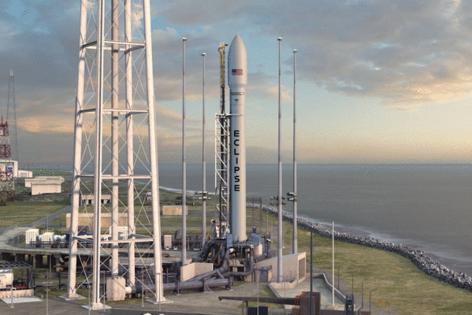Northrop Grumman doubles down on new rocket investment with Firefly
Published in Business News
Northrop Grumman and Firefly Aerospace have given a name to the future medium-lift rocket they plan to build: Eclipse.
The two companies are already partnered to help shepherd a new version of Northrop Grumman’s Antares rocket, which has not flown since 2023 when the company used the last of its supply of Russian-made engines for the rocket’s first stage.
A new version of the rocket called the Antares 330 will use seven of Texas-based Firefly’s Miranda engines on a redesigned first-stage the company is also developing. Firefly’s work on Antares 330 is flowing right into the design of the the larger Eclipse rocket.
Northrop Grumman, which is headquartered in West Falls Church, Virginia but has facilities all over the nation including in Florida, announced it was investing a further $50 million into Firefly’s development of Eclipse.
The new rocket, which won’t debut until at least 2026, aims to support space station resupply missions, commercial spacecraft, national security missions and scientific payloads for domestic and international markets, according to a joint press release from the two companies.
Eclipse will also be bigger than Antares 330, which could only fly about 17,500 pounds of payload to low-Earth orbit.
Eclipse, though, aims to increase capacity to about 36,000 pounds to low-Earth orbit, which is still smaller than the roughly 50,000-pound capacity of SpaceX’s Falcon 9 and ULA’s new Vulcan, which can fly up to 60,000 pounds.
Firefly CEO Jason Kim said Eclipse is in a “sweet spot” for programs like the National Security Space Launch contracts designed for higher-risk newcomers. It will also be perfect to support commercial satellite constellations, he said.
Firefly has its own small-capacity rocket, Alpha, but it has seen limited success on launch. But its other space-based programs have been very accomplished so far, including the first commercial lunar landing to not tip over when its Blue Ghost competed a mission under NASA’s Commercial Lunar Payload Services contract.
Eclipse’s design is based on a combination of Antares and Alpha, and will have an 18-foot-diameter fairing similar to Falcon 9 and Vulcan.
Northrop Grumman continues to fly its Cygnus resupply spacecraft to the International Space Station, but has had to hand off launch services to SpaceX until its new Antares is ready.
“Eclipse gives customers the right balance of payload capacity and affordability,” said Wendy Williams, Northrop Grumman’s vice president and general manager for its launch and missile defense systems. “Our partnership with Firefly builds on our capacity to provide crucial spaced-based communication, observation and exploration for civil and national security customers.”
Both the Antares 330 and the new Eclipse rocket will launch from Virginia’s Eastern Shore from NASA’s Wallops Flight Facility, although Firefly also has a launch lease at Cape Canaveral Space Force Station.
Eclipse will be built in Briggs, Texas and Chandler, Arizona with qualification testing already underway.
The debut of the new Antares rocket could still be this year, possibly for the next Cygnus resupply mission, NG-23, that wouldn’t fly until this fall.
©2025 Orlando Sentinel. Visit at orlandosentinel.com. Distributed by Tribune Content Agency, LLC.












Comments